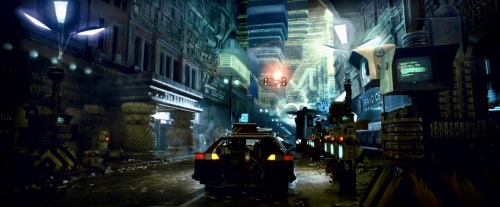Otherworlding - Otherworlds

More Posts from Otherworlding and Others


Concept art for WALLACE AND GROMIT by Nick Park.










Vintage publicity images for TWIN PEAKS.
Three things define the early 90s for me: The Simpsons, grunge music, and Twin Peaks.
I was 13: not a kid anymore, not really a teen yet; I mean not the kind of teen you are when you’re 16. I used to ride to school on my bike thinking about Twin Peaks: the music, characters, scenes, the warm visuals, the whispering trees, just the strange, otherworldly sense around it. The suspense was murder. Everything seemed charged with mystery, even traffic lights and ceiling fans. Twin Peaks is the shadow version of America’s can-do optimism.
That’s where my head was for about a year, I was constantly thinking about Twin Peaks. None of the other kids in my class watched the show, so it felt like my own dream world. Nobody knew but me. But then it has been like that for most of my life.




The Starchild from 2001: A SPACE ODYSSEY (1968), a page from Jack Kirby’s 1977 adaptation, and the original prop on display.










British children’s TV 1970s-1980s.
Henry’s Cat, Chorlton and the Wheelies, Roland Rat, Button Moon, Postman Pat, The Flumps, Rentaghost, The Wombles, Fingermouse, Bagpuss.





ALICE IN WONDERLAND by sci-fi and fantasy illustrator, Rodney Matthews.




Illustrations by Chica for a 1976 French edition of THE HOBBIT. Love that Gollum.
I’ve featured several foreign editions of the book (and LOTR in general) now. It’s interesting to compare the different versions and styles, the literal and the faithful, and the wild and the weird. Illustrations that differ too much from the descriptions in the book can be jarring, whereas illustrations that too literally depict what’s already vividly described in prose can make you wonder, Why even bother with illustrations?



Concept paintings for 2001: A SPACE ODYSSEY (1968).





RESTRICTED AREAS. Abandoned Soviet structures, photographed by Danila Tkachenko.










The world of BLADE RUNNER (1982).
Hm, suddenly I feel like drinking Coca-Cola. Strange.






Nightlife in Hong Kong in the 1970s. Photos by Greg Girard.
-
 otherworlding reblogged this · 4 months ago
otherworlding reblogged this · 4 months ago -
 razorback-bastard liked this · 4 years ago
razorback-bastard liked this · 4 years ago -
 gorekat64 reblogged this · 4 years ago
gorekat64 reblogged this · 4 years ago -
 gorekat64 liked this · 4 years ago
gorekat64 liked this · 4 years ago -
 wormwood2069 reblogged this · 4 years ago
wormwood2069 reblogged this · 4 years ago -
 wormwood2069 liked this · 4 years ago
wormwood2069 liked this · 4 years ago -
 chaoticcashroadbagel liked this · 4 years ago
chaoticcashroadbagel liked this · 4 years ago -
 lonni03 liked this · 4 years ago
lonni03 liked this · 4 years ago -
 fundipqween liked this · 4 years ago
fundipqween liked this · 4 years ago -
 racodaraccoon liked this · 5 years ago
racodaraccoon liked this · 5 years ago -
 d0lanz liked this · 5 years ago
d0lanz liked this · 5 years ago -
 kerfufflearts liked this · 5 years ago
kerfufflearts liked this · 5 years ago -
 jespertheklaun liked this · 5 years ago
jespertheklaun liked this · 5 years ago -
 edgar-allan-possum liked this · 5 years ago
edgar-allan-possum liked this · 5 years ago -
 takineko reblogged this · 5 years ago
takineko reblogged this · 5 years ago -
 takineko liked this · 5 years ago
takineko liked this · 5 years ago -
 pressed-beetlejuice liked this · 5 years ago
pressed-beetlejuice liked this · 5 years ago -
 noveltysizedproducts liked this · 5 years ago
noveltysizedproducts liked this · 5 years ago -
 slothfullyme liked this · 5 years ago
slothfullyme liked this · 5 years ago -
 squashedfroggy-blog1 liked this · 5 years ago
squashedfroggy-blog1 liked this · 5 years ago -
 dragoneyesstuff liked this · 5 years ago
dragoneyesstuff liked this · 5 years ago -
 depressedcongoer reblogged this · 5 years ago
depressedcongoer reblogged this · 5 years ago -
 proudoftayy liked this · 5 years ago
proudoftayy liked this · 5 years ago -
 demeninu liked this · 5 years ago
demeninu liked this · 5 years ago -
 couerdixble reblogged this · 5 years ago
couerdixble reblogged this · 5 years ago -
 ashfield-heights liked this · 5 years ago
ashfield-heights liked this · 5 years ago -
 daizybelleschaos liked this · 5 years ago
daizybelleschaos liked this · 5 years ago -
 massimoognibene liked this · 5 years ago
massimoognibene liked this · 5 years ago -
 horchathot reblogged this · 5 years ago
horchathot reblogged this · 5 years ago -
 horchathot liked this · 5 years ago
horchathot liked this · 5 years ago -
 motherfuckign reblogged this · 5 years ago
motherfuckign reblogged this · 5 years ago -
 lovesparklyblizzardbouquet-blog liked this · 5 years ago
lovesparklyblizzardbouquet-blog liked this · 5 years ago -
 polarluxray liked this · 5 years ago
polarluxray liked this · 5 years ago -
 pawteodia reblogged this · 5 years ago
pawteodia reblogged this · 5 years ago -
 eclecticimaginings liked this · 5 years ago
eclecticimaginings liked this · 5 years ago
